Understanding Haem Iron: Its Role and Significance
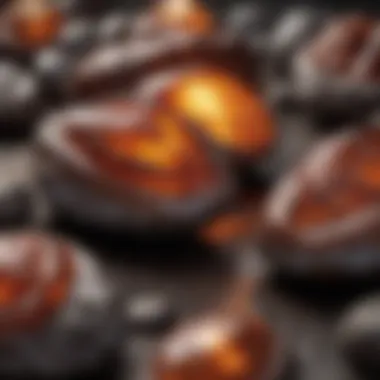
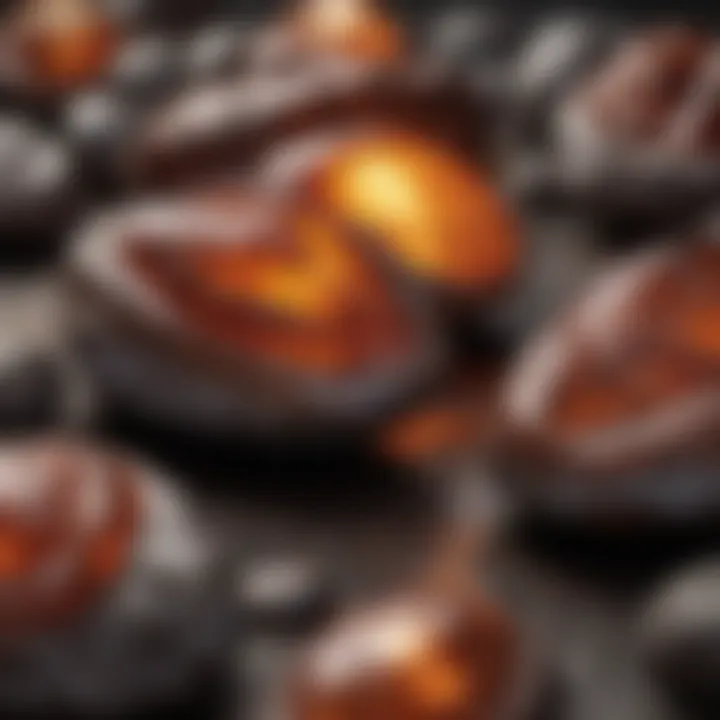
Intro
Haem iron, a fascinating component of our diet, plays a critical role in our overall health and physiology. Found primarily in animal-based foods, this nutrient is indispensable for various bodily functions. Understanding haem iron is not just an academic exercise; it has real implications for populations around the globe, especially in communities where dietary patterns may compromise adequate iron intake.
However, before we dive deeper into the specifics, it's crucial to outline key areas of discussion regarding haem iron. From sources to health impacts, we will break down how our bodies process this unique nutrient and why it matters in the world of nutrition. Let's embark on this journey to unveil the mysteries surrounding haem iron's significance.
Research Overview
Summary of Key Findings
Research has consistently shown that haem iron is generally better absorbed by the body than its non-haem counterpart. A striking finding is that the absorption rate of haem iron is about 15% to 35%, whereas non-haem iron hovers around 2% to 20%. This discrepancy highlights the importance of dietary choices.
Key points include:
- Sources of Haem Iron: The most concentrated sources are red meats, poultry, and fish. On the other hand, non-haem iron can be found in plant-based foods such as legumes and leafy greens, but it poses greater challenges in terms of absorption.
- Health Implications: Insufficient haem iron intake can lead to conditions such as iron-deficiency anemia, which can have widespread implications on energy levels, cognitive function, and overall quality of life.
Background and Context
Historically, iron deficiency has been a public health concern, affecting millions around the world. Various studies have highlighted the need to differentiate between haem and non-haem iron due to their varying bioavailability. A rich body of literature discusses how factors such as vegetarian diets or lower meat consumption predispose certain groups to iron deficiency.
The significance of haem iron extends beyond basic nutrition; it also encompasses wider implications for dietetic practices and health recommendations. This connection is crucial for health educators and dietitians, especially when providing dietary advice tailored to individual needs.
Methodology
Experimental Design
Most studies explore the absorbtion characteristics and effects of haem iron through controlled feeding trials. Participants typically consume meals with varied levels of haem and non-haem iron while their iron status is monitored through blood tests. Such controlled experiments allow researchers to gather precise data regarding how different iron forms behave in the body.
Data Collection Techniques
Data is usually collected through a combination of blood test results, dietary assessments, and participant questionnaires. This multifaceted approach ensures that a holistic view is taken when analyzing how haem iron affects health outcomes. Various tools and technologies are employed, from bioelectrical impedance analysis for body composition to sophisticated lab equipment for nutrient quantification.
"Understanding the dual nature of hem iron and non-hem iron is key to addressing iron deficiency across different populations."
Epilogue
In summary, haem iron presents a unique opportunity to enhance dietary health through informed choices. The ongoing research continues to shed light on its vital role in human physiology. As we move forward, recognizing the implications of haem iron in our diets may pave the way for better health outcomes and nutritional education.
Preface to Haem Iron
Haem iron stands front and center as a crucial element of nutrition, playing a vital role in human health and biology. Often overshadowed by its non-haem counterpart, haem iron merits a closer examination due to its unique composition and absorption efficiency. This section will explore the essence and significance of haem iron, shedding light on its intricate nature and the implications for personal health and well-being.
Definition and Composition
Haem iron is a type of iron that is specifically derived from animal sources. It is predominantly found in muscle tissues and hemoglobin, the protein responsible for transporting oxygen in the blood. The structure of haem iron consists of a porphyrin ring with an iron atom at its core, which allows it to bind effectively with oxygen. This composition not only enhances its absorption rate in the human body but also makes it essential for various biochemical processes.
Key Takeaway: Haem iron differs from non-haem iron in both source and structure, significantly impacting how it is absorbed and utilized by the body.
Sources of Haem Iron
When it comes to dietary sources, haem iron primarily finds its way to our plates through the consumption of animal products. Here’s a look at some rich sources of this important nutrient:
- Red Meat: Beef, lamb, and pork are packed with haem iron. Steaks and roasts often top the list as hearty sources.
- Poultry: Chicken and turkey contain haem iron, particularly in the darker cuts of the meat.
- Fish and Seafood: Many types of fish, such as salmon and tuna, along with shellfish like oysters and mussels, contribute significant amounts of haem iron to the diet.
While these animal-based foods are primary sources, understanding how to incorporate them thoughtfully into a balanced diet is essential. For individuals following vegetarian or vegan diets, the challenge of obtaining sufficient haem iron without animal sources is notable, highlighting the importance of understanding its dietary roles and health implications.
The Biology of Iron
Iron is not just another supplement—it's an essential player in a whole range of biological functions. The element is often referred to as a micronutrient, and its significance runs deep through our physiological processes. It offers benefits that range from oxygen transport to energy metabolism, and understanding its biology helps clarify why it matters so much in our daily lives and diets. The focus here is to unpack the layers of iron, particularly haem iron, and how it fits into the larger framework of nutrition and health.
Iron as a Micronutrient
Iron as a micronutrient plays a crucial role in many bodily functions. Rather than simply being a dietary requirement, iron acts almost like a Swiss Army knife in our biology. It is integral for synthesizing hemoglobin—the protein in red blood cells that carries oxygen throughout the body. Without sufficient iron, your body can struggle to generate enough hemoglobin, leading to conditions like anemia, which brings fatigue and other related issues.
In essence, iron is a key to unlocking a multitude of biochemical pathways. The World Health Organization (WHO) has identified iron deficiency as a critical public health issue, particularly in developing countries, highlighting a universal challenge that many face.
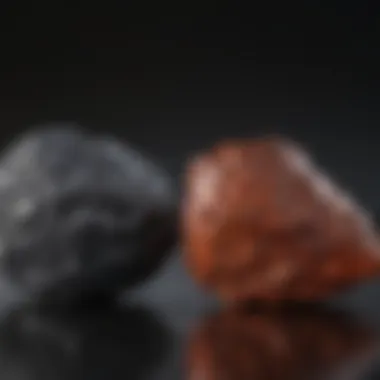
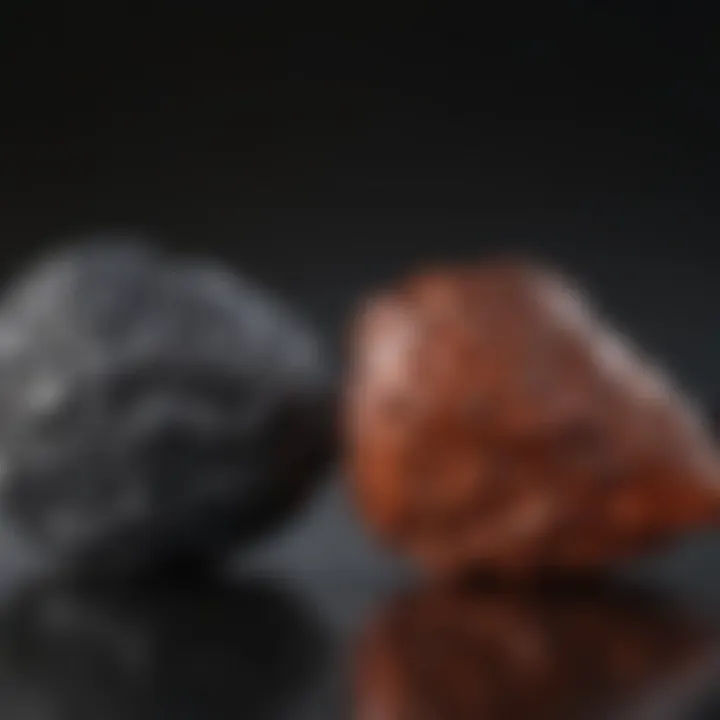
Forms of Dietary Iron
Understanding the forms of dietary iron is vital, as it hinges on how well our bodies can absorb this micronutrient. The two main categories of dietary iron are haem iron and non-haem iron, each with its own distinct characteristics and implications for health.
Haem Iron
When we talk about haem iron, we often think of its robust bioavailability—it’s the type of iron your body absorbs the most effectively. Found primarily in animal products, such as red meat, poultry, and fish, haem iron is closely tied to various physiological functions.
The notable aspect of haem iron lies in its structure, being bound to hemoglobin and myoglobin. This binding helps the iron maintain its amazing ability to be absorbed, typically at a rate of 20-30%, compared to around 2-10% for non-haem iron. This characteristic makes haem iron a popular choice for individuals looking to boost their iron intake quickly and effectively.
However, it does have its drawbacks. For example, an over-reliance on haem iron could lead to excess iron accumulation in the body, which is a double-edged sword. High levels of iron can contribute to oxidative stress and even cardiovascular issues. Hence, moderation is key no matter how beneficial haem iron might seem.
Haem iron, with its higher absorption rate, offers immediate benefits. Yet, one must be wary of the potential health complications associated with excess iron.
Non-Haem Iron
Non-haem iron is often found in plant-based foods such as lentils, beans, tofu, and fortified cereals. Its relatively lower bioavailability—around 2-10%—marks it as a less efficient source of iron compared to its haem counterpart. However, this type of iron has distinctive advantages. For one, it’s easier to incorporate into a varied vegetarian or vegan diet, allowing for a wider range of food options.
An interesting feature of non-haem iron is how its absorption can be enhanced by consuming it alongside vitamin C, which can significantly boost its uptake. This becomes particularly useful for those on plant-heavy diets who may struggle to meet their iron needs. On the flip side, it is easier for the body to regulate non-haem iron absorption, which minimizes the risks associated with excess consumption.
Absorption Mechanisms of Haem Iron
The absorption of haem iron is a critical aspect of its role in nutrition, influencing how efficiently our bodies utilize this essential nutrient. Understanding these mechanisms is key for anyone interested in the interplay between diet and health outcomes. Haem iron, primarily derived from animal sources, is absorbed more readily than its non-haem counterpart, which can significantly impact nutritional strategies.
Digestion and Uptake
When we consume foods containing haem iron, the digestion process begins in the stomach. The acid present helps to release iron from proteins, allowing it to be absorbed in the intestines. Unlike non-haem iron, which often requires conversion to a more soluble form, haem iron is absorbed intact. This efficiency is largely attributed to the presence of a special transporter protein in the intestinal lining called HCP1 (heme carrier protein 1).
Once in the intestines, haem iron meets specific transporters that facilitate entry into the bloodstream. Once absorbed, iron can be utilized in various bodily functions, most notably synthesizing hemoglobin and myoglobin, essential proteins for oxygen transport and storage, respectively. Anyone with an interest in physiology or nutrition should note that this unique pathway highlights the importance of including sufficient sources of haem iron to meet physiological needs.
Factors Affecting Absorption
While haem iron is generally more bioavailable than non-haem iron, several factors can influence its absorption. Here are some key elements to consider:
- Dietary Components: Certain foods can enhance or inhibit iron absorption. For instance, vitamin C is known to facilitate the absorption of both haem and non-haem iron. On the flip side, substances like tannins found in tea and coffee, as well as calcium, can hinder absorption.
- Biochemical State: The human body maintains iron homeostasis through various mechanisms. In conditions of deficiency, absorption rates can increase, while in overload situations, it can decrease, showcasing the body's remarkable ability to regulate iron levels.
- Health Status: Individuals with certain health conditions, such as celiac disease or inflammatory bowel diseases, may experience altered absorption rates. This can lead to challenges in maintaining healthy iron levels.
"The efficiency of haem iron absorption is a double-edged sword; while it means better iron status for those consuming it, it also raises the need for awareness of overall intake and potential health implications."
Comparative Analysis: Haem and Non-Haem Iron
The distinction between haem and non-haem iron is crucial for a comprehensive understanding of iron nutrition, especially when considering dietary guidelines and health implications. By analyzing these two forms of iron, we can gain insights into their respective bioavailability, absorption rates, and their roles in human health. This section emphasizes why this comparative analysis is necessary, particularly for individuals who may be at risk of iron deficiency or have specific dietary considerations.
Bioavailability Differences
Bioavailability refers to the proportion of a nutrient that is absorbed and utilized by the body. Haem iron, primarily found in animal products, boasts a higher bioavailability compared to its non-haem counterpart, which is predominantly sourced from plant-based foods.
- Absorption Rates: Research indicates that haem iron is absorbed at a rate of approximately 15% to 35%, making it significantly more efficient than non-haem iron, which typically averages around 2% to 20% absorption.
- Influencing Factors: While non-haem iron absorption can be impacted by various dietary components (like tannins in tea or phytates in whole grains that inhibit absorption), haem iron is less affected. This means that even in less ideal digestive conditions, haem iron remains a reliable resource for maintaining adequate levels.
Given these differences, individuals who consume a diet rich in haem iron may have a straightforward path to fulfilling their iron needs, whereas individuals relying mainly on non-haem iron must be more strategic in their food choices to maximize absorption.
Impact on Nutritional Recommendations
The insights drawn from comparing haem and non-haem iron are integral for crafting dietary recommendations that address the diverse needs of different populations.
- Dietary Guidelines: Nutritional guidelines often emphasize the importance of including haem sources in the diet, particularly for populations at greater risk of iron deficiency, such as pregnant women, children, and individuals with certain health conditions.
- Dietary Planning: Healthcare professionals encourage those who predominantly consume plant-based diets to pair non-haem iron sources with vitamin C-rich foods—like citrus fruits or bell peppers— to enhance absorption. This kind of planning allows for a more balanced approach that values both sources of iron.
"The understanding of iron bioavailability shapes dietary choices and dietary interventions, particularly for populations susceptible to deficiency."
Ultimately, recognizing the contrasts between haem and non-haem iron fosters informed decisions in dietary practices and helps tailor nutritional strategies to individual needs. Equipped with this knowledge, health professionals and educators can better address the wider implications of iron nutrition in various demographic groups.
Health Implications of Haem Iron
The significance of haem iron extends far beyond its basic role as a nutrient. Its implications for health are profound and multifaceted. Understanding how haem iron functions in the body allows for an appreciation of its benefits as well as its potential downsides. This section delves into the critical aspects of haem iron's relationship with health, particularly in terms of hemoglobin formation and the associations it has with chronic diseases.
Role in Hemoglobin Formation
Hemoglobin is the protein in red blood cells that carries oxygen from the lungs to various parts of the body. Haem iron is a core component of hemoglobin, making it essential for effective oxygen transport. The presence of haem iron directly influences the efficiency of hemoglobin synthesis. When your body effectively absorbs haem iron, it ensures that hemoglobin production runs smoothly.
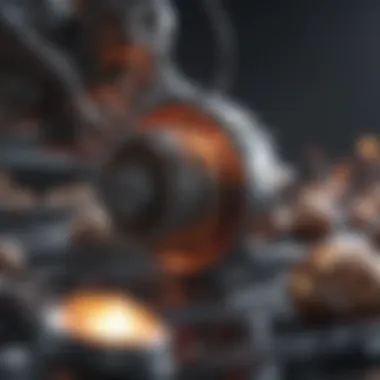
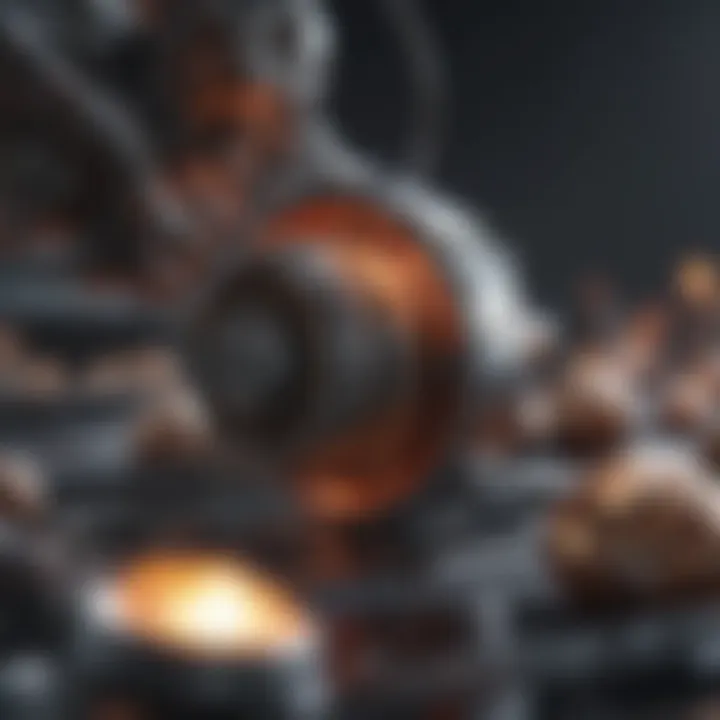
An interesting point to note is that while non-haem iron can also contribute to hemoglobin formation, haem iron is absorbed more readily. For those who engage in rigorous physical activities or reside at higher altitudes, where oxygen levels are lower, maintaining healthy haem iron levels can significantly enhance stamina and overall physical performance.
Not only does haem iron support oxygen transport, but it also plays a role in cellular respiration. This means it helps convert nutrients into energy, highlighting its importance in maintaining energy levels throughout the day. However, individuals must manage their iron intake carefully, as too much iron can lead to toxicity, posing additional health risks.
Associations with Chronic Diseases
Chronic diseases such as cardiovascular conditions and different types of cancer have often been linked to dietary iron. Haem iron, due to its potent absorption characteristics, may play a more significant role in these health concerns than previously thought.
Cardiovascular Health
In terms of cardiovascular health, recent studies suggest that while iron is essential, excess intake can lead to oxidative stress. This phenomenon is thought to cause damage to blood vessels and contribute to the development of conditions like arteriosclerosis. It is crucial to strike a balance: having adequate haem iron is indispensable for red blood cell functionality, but overconsumption can be detrimental.
A key characteristic of cardiovascular health in relation to iron is how it can influence blood pressure. People with low levels of haem iron often experience fatigue and decreased cardiovascular efficiency. Conversely, those with excessive levels might find themselves at increased risk for heart diseases. Thus, proper management and dietary considerations regarding haem iron could be pivotal in both preventing and managing cardiovascular problems.
Cancer Risk
When we talk about cancer risk, the relationship with haem iron is complex. Some studies have suggested that high levels of dietary haem iron might be associated with an increased risk of certain cancers, especially colorectal cancer. The argument here hinges on the notion that excess iron may lead to the promotion of free radical formation in the gastrointestinal tract, potentially leading to cellular damage. However, it’s also essential to point out that iron is necessary for many biological processes, including the immune response.
The unique feature of cancer risk concerning dietary habits is that individuals are encouraged to have a balanced approach to their iron intake. Iron-rich foods, such as red meats, should not be completely eliminated, but consumption should be monitored and managed. This is particularly true for populations high in red meat consumption who might fit into the higher risk categories.
Maintaining a balanced diet, enriched with diverse sources of nutrients, is vital in mitigating the risks associated with excessive or insufficient intake of haem iron.
Understanding the health implications of haem iron underscores the necessity for dietary vigilance. Striking a balance is crucial, as both deficiency and excess pose their own set of challenges. The insights gleaned from ongoing research are indispensable for reframing how we approach haem iron in our diets. As public awareness evolves, so too does our understanding of the integral role it plays in human health.
Dietary Sources of Haem Iron
Understanding the dietary sources of haem iron is crucial in the context of this article. Haem iron is a vital nutrient that supports numerous physiological functions, and its sources play a significant role in maintaining healthy iron levels in the body. By examining the specific foods high in haem iron, we can appreciate the nuances of its consumption and the benefits rendered in our diets.
Animal Sources
Red Meat
Red meat, including beef, lamb, and pork, stands out as a primary source of haem iron. Its rich, deep color is a telltale sign of the iron content embedded within. Red meat offers a potent concentration of iron that’s highly absorbable—far more so than its plant-based counterparts. The key characteristic of red meat lies in its ability to significantly boost haemoglobin levels, which is important in preventing anemia.
The unique feature here is not just its high iron content but also the presence of other nutrients like zinc and B vitamins, which synergistically work with iron to enhance overall health. On the flip side, excessive consumption of red meat, particularly processed forms, can raise concerns over heart disease and certain cancers. Therefore, incorporating red meat in moderation is advisable.
Poultry
Poultry, particularly chicken and turkey, is another valuable source of haem iron. The major advantage of poultry is its versatility in dishes while being relatively lower in fat compared to red meat. Chicken breast is particularly favored for those looking to maintain a leaner diet while still acquiring necessary iron levels. Poultry is generally accepted as a more palatable option for many, which makes it a beneficial choice for varied dietary preferences.
Another aspect to consider is the unique feature of poultry being easier to cook and prepare in various types of meals. However, it’s important to note that poultry contains less haem iron compared to red meat, so focusing on the darker cuts, such as thighs and wings, may offer better benefits.
Fish
Fish is often hailed as a healthful choice, and when it comes to haem iron, it's no different. Varieties like tuna and mackerel not only provide iron but also omega-3 fatty acids, which are known for their cardiovascular benefits. The key characteristic of fish is its generally lighter makeup, making it easy to digest while still contributing to iron intake.
One unique feature of fish is the presence of compounds like heme iron, which aids in absorption unlike some plant-based sources. However, fish may vary in iron content, with some types being relatively low. Thus, opting for richer options or integrating fish regularly into your meals can help in boosting haem iron intake.
Plant-Based Alternatives
While haem iron sources are predominantly animal-based, there have been advancements in plant-based diets providing iron-rich alternatives. This section will dive deeper to explore options that vegetarians and vegans can consider, without sacrificing nutrient intake or overall health.
Populations at Risk for Haem Iron Deficiency
Understanding who is at higher risk for haem iron deficiency is essential. Certain groups may find themselves facing unique challenges when it comes to adequate iron intake. Identifying these populations allows for tailored nutritional guidance and interventions. Recognizing the symptoms and conditions associated with iron deficiency can help in making better dietary choices and implementing effective measures to improve health outcomes.
Vegetarian and Vegan Diets
Individuals following vegetarian or vegan diets often rely on plant-based sources of nutrition. While these diets can offer a host of benefits, they might also lead to insufficient iron levels. This is particularly true for haem iron, which is primarily found in animal products.
- Absence of Haem Iron: Vegetarians and vegans miss out on haem iron, a type of iron that is more easily absorbed by the body. Instead, they consume non-haem iron from sources like legumes, nuts, and leafy greens. However, non-haem iron is not absorbed as well, which can lead to deficiencies over time.
- Increased Iron Requirements: Those on plant-based diets may need higher amounts of iron compared to those who consume meat. This increased need can arise due to lower bioavailability of iron from plant sources, necessitating the consumption of more iron-rich foods or fortified products.
- Considerations for Supplementation: While plant-based eaters can meet their iron needs, many might consider iron supplements. It's vital to approach supplementation with caution, as excessive iron intake can lead to health concerns. Consulting with a healthcare provider ensures that any supplementation aligns with dietary choices.
Pregnant and Lactating Women
Pregnancy and lactation create significant nutritional demands. Women within these life stages must be particularly aware of their iron intake owing to the increased requirements caused by fetal development and breastfeeding.


- Heightened Iron Needs: Pregnant women require about 27 mg of iron daily, nearly double the amount recommended for non-pregnant women. This need arises as iron is crucial for making hemoglobin, which transports oxygen to both mother and baby.
- Risk of Deficiency: If dietary iron intake fails to meet the heightened demands, it can lead to iron deficiency anemia, which may present symptoms like fatigue, weakness, and even complications during childbirth.
- Nutrition Strategies: Women in this group should prioritize haem iron-rich foods like lean meats, poultry, and fish while also combining these with vitamin C-rich foods to enhance non-haem iron absorption from plants. Iron-fortified cereals and supplements can also bridge the gap, though it's prudent to discuss this with health professionals.
The Role of Fortification and Supplementation
When discussing dietary micronutrients, fortification and supplementation emerge as pivotal strategies in promoting public health. Particularly for haem iron, these strategies can serve as vital interventions to combat deficiencies, especially in populations that struggle to meet their iron needs through diet alone. The importance of focusing on haem iron is underscored by its superior bioavailability compared to non-haem iron, making fortification and supplementation essential considerations for addressing iron deficiency.
Food Fortification Strategies
Food fortification involves the intentional addition of nutrients to food products to enhance their nutritional content. This can include adding haem iron to commonly consumed items, which can significantly boost the dietary intake of this crucial mineral.
Some of the noteworthy food fortification strategies include:
- Enriched grains: Certain bakeries and processors are now incorporating haem iron into bread and cereals, making it easier for consumers to get iron without major changes to their diets.
- Meat products: Processed meats, such as sausages or deli slices, can be fortified with added haem iron to cater to those who are at risk for deficiency but may not consume enough red meat.
- Dairy alternatives: Plant-based milk products can also be fortified with haem iron, appealing to vegans or those who are lactose intolerant but may still require adequate iron levels.
With a growing body of evidence pointing to the role of fortified foods in preventing deficiencies, food manufacturers are increasingly recognizing the value of incorporating haem iron into their products. The challenge lies in how to balance iron fortification without affecting the sensory properties of foods or providing excessive amounts that might pose health risks.
Supplemental Products
Supplementation represents another avenue to effectively increase haem iron intake, particularly for individuals who may not be able to meet their requirements through diet alone. Various forms of haem iron supplements exist, catering to diverse needs and preferences.
A few key types of supplements include:
- Capsules and Tablets: Formulated to deliver concentrated doses of haem iron, these are often prescribed for those diagnosed with iron deficiency anemia.
- Liquid supplements: Typically favored by children or individuals who struggle with swallowing pills, liquid haem iron supplements can provide an easier alternative while still ensuring adequate intake.
- Chewable tablets: Designed for those who prefer a more palatable option, chewable haem iron supplements also offer the same benefits in a more enjoyable format.
Iron supplementation should always be approached with caution, and ideally under the guidance of a healthcare professional to avoid potential toxicity or adverse effects.
In addition, it’s crucial to acknowledge individual variation in iron absorption and metabolism. Not everyone may respond the same way to iron supplementation, hence the need for tailored approaches based on specific health needs and dietary habits.
By prioritizing both fortification and supplementation alongside proper education, communities can take significant steps to alleviate the iron deficiency burden, ultimately promoting better health outcomes. Specific populations, like pregnant women or vegetarians, stand to benefit greatly from these interventions.
Research Trends in Haem Iron Studies
The study of haem iron is gaining traction as researchers delve into its multifaceted role in nutrition and health. This section reflects the increasing recognition of haem iron not just as a nutritional element, but as a critical player in various physiological processes. The importance of understanding the recent research trends is paramount; they can unveil ways haem iron influences both individual health and public health policies. Key studies are emerging that scrutinize absorption mechanisms, health implications, and the relationship of haem iron to chronic diseases.
Moreover, public health initiatives can benefit from these findings, ultimately guiding better dietary recommendations. The exploration of this field offers insights into how haem iron can spark improvements in our overall health and nutrition.
Emerging Studies and Findings
Recent studies are painting a clearer picture of how haem iron interacts within the body. One significant area of research focuses on the bioavailability of haem versus non-haem iron. For example, findings suggest that haem iron is absorbed more efficiently, indicating that dietary strategies should place greater emphasis on sources rich in this form of iron. This research lays an insightful groundwork for designing dietary interventions aimed at preventing iron deficiency.
Another key area involves examining the link between haem iron intake and chronic diseases. Some studies suggest a correlation between high haem iron consumption and increased risk for conditions such as cardiovascular disease and certain types of cancer. Understanding these associations helps researchers dissect the nuances of diet's contribution to long-term health outcomes.
"The efficacy of haem iron in absorption transcends mere biology; it connects directly to lifestyle choices and public health concerns broadening the scope of dietary recommendations."
Future Research Directions
Looking ahead, several research avenues could provide deeper insights into the role of haem iron. One promising direction is the impact of haem iron on gut health. As more is discovered about the human microbiome, the interactions between dietary iron and gut microbes may reveal new pathways that affect both absorption and overall health. This could inform strategies to enhance the efficacy of haem iron when consumed in conjunction with other nutrients.
Another prospective focus is on the population-specific responses to haem iron. For instance, future studies may involve investigating how genetic differences affect iron metabolism and absorption, especially in underrepresented groups. Such research could be crucial for tailoring nutritional guidelines that better reflect diverse needs.
Lastly, continued exploration into the long-term effects of haem iron on health outcomes will be vital. This entails not merely statistical analyses but longitudinal studies that track populations over years to assess the impact of haem iron on various health metrics, offering a robust picture of its significance in dietary patterns.
By prioritizing these avenues, researchers can refine our understanding of haem iron's role, making strides towards effective public health solutions.
Ending: Understanding the Implications of Haem Iron
Haem iron plays a crucial role in nutrition and human health. Its distinct advantages over non-haem iron make it a subject worth delving into deeply. This section summarizes the key points discussed in the article and consolidates our understanding of haem iron’s significance and its implications on dietary choices and health outcomes.
The supportive evidence from various research studies underscores the importance of haem iron, especially in populations more vulnerable to iron deficiency. These insights lay the groundwork for informed dietary choices and future studies. Thus, grasping the role of haem iron is not just academic; it has real-world implications for health and well-being.
Summary of Key Takeaways
- Bioavailability: Haem iron, found primarily in animal sources, is absorbed more efficiently by the body than non-haem iron, which predominates in plant-based foods.
- Health Implications: Adequate intake of haem iron is linked to enhanced hemoglobin production, making it vital for maintaining energy levels and preventing anemia.
- Dietary Sources: Foods rich in haem iron, like red meat, poultry, and certain fish, should be included in diets for individuals at risk of deficiency.
- Vulnerable Populations: Specific groups, such as vegetarians, pregnant women, and those with increased iron needs, must pay special attention to obtaining enough haem iron or its alternatives.
"Understanding haem iron is as essential as understanding the workings of our very own body; it's a piece of the puzzle that solves many nutritional issues."
Recommendations for a Balanced Diet
To ensure that individuals receive adequate haem iron for optimal health, consider the following recommendations:
- Diversify Protein Sources: Integrate a variety of animal-based proteins, like lean red meat and poultry, into your meals several times a week.
- Mindful Pairing: Enhance the absorption of haem iron by pairing it with foods high in vitamin C, such as bell peppers, citrus fruits, and berries during meals.
- Consider Fortified Options: For those following strict plant-based diets, it’s prudent to include fortified foods or supplements that contain bioavailable iron forms to bridge any nutritional gaps.
- Regular Monitoring: Individuals in high-risk categories should monitor their iron levels regularly and consult healthcare providers for tailored dietary advice and strategies.
In summary, fostering a deeper understanding of haem iron not only enriches nutritional knowledge but also empowers individuals to make informed dietary decisions that promote health and well-being.







